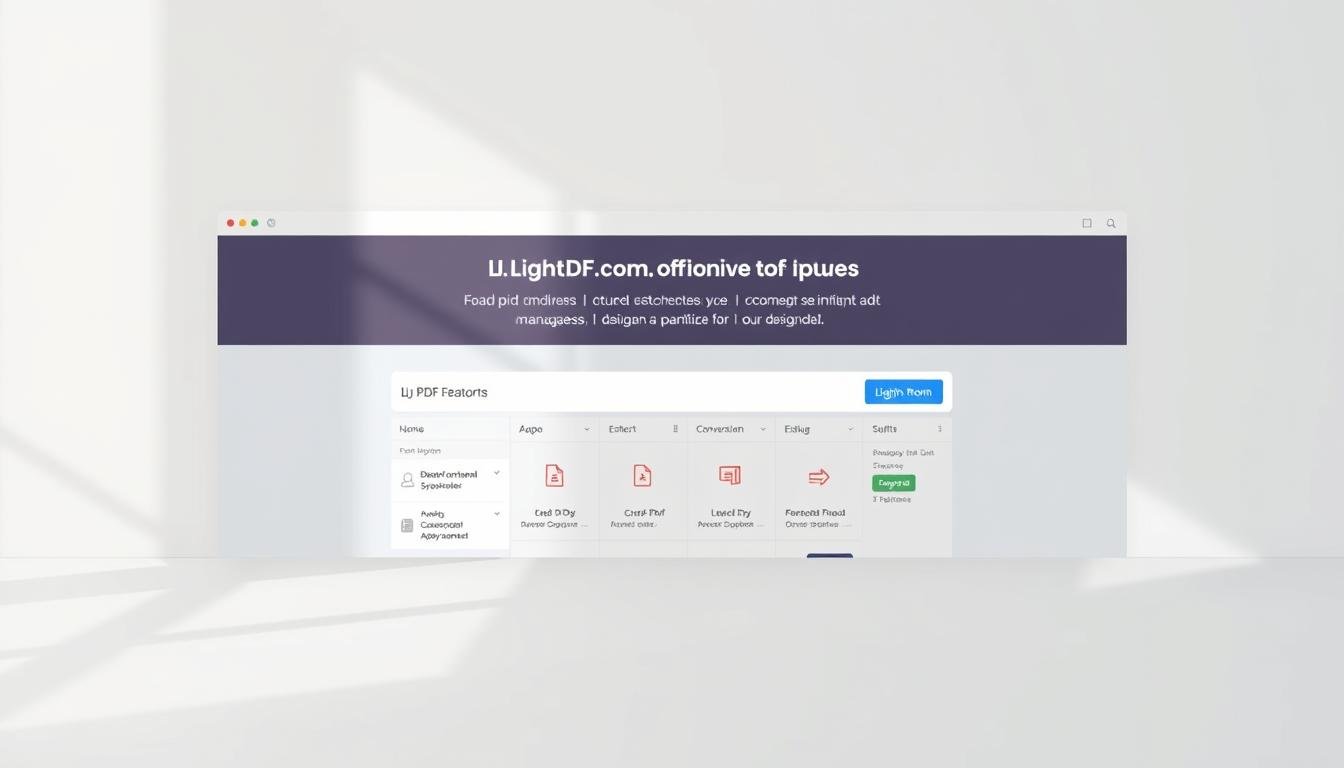LightPDF.com offers a simple way to handle PDF tasks online. You don’t need to install software. It lets you convert files, edit text, merge pages, and more right in your web browser.
This online pdf editor is great for students, small businesses, freelancers, and professionals. It’s perfect for tasks like preparing email attachments and optimizing files for the web. It’s also useful for creating presentation-ready documents and archiving records.
LightPDF.com is faster and easier to use than big cloud services. It offers quick conversions like pdf to word and pdf to jpg. It also has a lightweight online pdf editor for fast editing. Plus, it has both free and premium features for different needs.
Key Takeaways
- LightPDF.com offers a browser-first, no-install approach to common PDF tasks.
- It combines conversion, editing, merging, splitting, compression, and annotation tools.
- The platform is practical for U.S. users like students, businesses, and legal professionals.
- Quick conversions (pdf to word, pdf to jpg) and a lightweight online pdf editor boost productivity.
- Free tools cover most needs, with premium options for advanced workflows.
Why Choose LightPDF.com for Your PDF Needs
LightPDF.com makes it easy to start working right away. You can convert, compress, or edit PDFs without any software. This is perfect for those who need quick results and fast downloads.

Fast, browser-based PDF workflow
Converting and compressing PDFs online is super fast. Just upload your file, pick what you want to do, and download your result in seconds. This is great for when you’re in a hurry or working with others.
Accessible from any device in the United States
LightPDF works on all kinds of devices. You can edit PDFs on your computer, tablet, or phone. This is great for teams and people who work on the go.
Security and privacy considerations for online PDF tools
Keeping your files safe is important. LightPDF.com uses HTTPS for secure transfers and temporary storage. Some tools even let you process files on your device for extra privacy.
- Check retention policies before uploading sensitive material.
- Use client-side options when available for extra privacy.
- Confirm uptime and status if reliability is critical for workflows.
Core Online PDF Tools Offered
LightPDF offers a range of tools to make PDF tasks easier. You can edit documents, merge pages, or reduce PDF sizes for emailing and storing.

The pdf converter tools quickly change PDFs into editable formats. The pdf to word converter keeps text and layout for editing in Microsoft Word. The pdf to jpg converter turns pages into images for presentations and websites.
- Quickly extract text for reports and edits.
- Save visuals as jpg for slides and blogs.
- Switch between PowerPoint, Excel, and image formats with confidence.
Merging and splitting files is easy with the merge and split tools. Use the pdf merger to combine contracts, receipts, or reports into one document. Split pdf or pdf splitter can break a large file into smaller parts by page range.
- Merge multiple PDFs and reorder pages before saving.
- Split PDF files to send only the pages recipients need.
- Organize invoices, chapters, or attachments with a few clicks.
Large files are hard to share. The pdf compressor reduces size without losing readability. Choose the compress pdf online option to adjust quality and file size.
The tools also handle everyday tasks beyond conversion, merging, and compression. You can edit, annotate pdf, add watermarks, and extract images or pages. LightPDF makes office and school tasks simple.
How to Convert PDF to Word with LightPDF
Converting a PDF to an editable Word document is easy with LightPDF. Follow these steps for a reliable online conversion process. It keeps your formatting and offers options for scanned files.
Step-by-step process for pdf to word converter
- Open LightPDF.com and pick the PDF to Word tool, the online pdf to word converter.
- Drag your file into the browser or use the file selector to upload it.
- Choose DOCX as the output format for the best layout when converting pdf to word.
- Enable OCR if your document is scanned or image-based before conversion.
- Click Convert, wait, then download the Word file. Open it in Microsoft Word or Google Docs to edit.
Tips for preserving formatting and layout
Choose DOCX and keep original page size settings to protect margins and spacing.
Make sure fonts on your device match those in the PDF. Missing fonts can change layout and force reflow.
Complex columns, tables, or graphics might need manual adjustments. Use Word’s style tools to restore headings, lists, and table structure after conversion.
When to use OCR and how it helps editable text
OCR is key for PDFs from scans or photos. It turns images of text into searchable, editable content for direct editing.
LightPDF’s OCR helps convert contracts, receipts, and printed forms into Word while keeping layout. After conversion, check suspect lines and run a spell-check to catch errors.
To finish, use Word’s “Reveal Formatting” and apply consistent styles. This speeds up cleanup and ensures headings, lists, and tables are correct.
Merge PDF Files and Split PDF Online
Many professionals need to combine and split PDFs for reports, invoices, and more. A clear workflow helps keep files organized and avoids mistakes when merging or splitting PDFs online.
Merging PDFs is easy. Just upload your files, reorder them if needed, and merge them into one PDF. This is great for putting together proposals, court documents, or year-end reports.
When merging PDFs online, save a copy before making changes. Check bookmarks, links, and metadata to make sure everything is correct.
Splitting PDFs starts with picking the right points to break them. Use page numbers, chapter markers, or invoice numbers to make each file useful to the recipient.
- Name files clearly, for example: Invoice_2025-06_Page1-3.pdf.
- Keep a master PDF to preserve the original sequence and metadata.
- Use a pdf splitter that supports page range selection and preview before saving.
For big tasks, use batch uploads and ordering in online merge tools. Organize files by folder, compress them if you can, and name them consistently to keep things in order.
If you do lots of big tasks, think about automation or a paid plan. This can help with size limits and speed. Always check your work after batch operations to make sure everything is right.
When splitting PDFs, only export what you need to make files smaller and control access. Use split pdf tools to pull out chapters, separate invoices, or make single-topic documents for sharing.
Compress PDF Online to Save Space
Freeing up storage and speeding delivery are key reasons to compress PDF files. LightPDF’s tools make it easy to reduce file size. You can choose the quality and output you need.
Choosing compression levels: quality vs. file size
Most pdf compressor online tools, like LightPDF, offer presets. You can choose from best quality, balanced, and smallest size. High compression makes files small but can blur images.
Low compression keeps things clear but saves less space. For business forms or text reports, pick a setting that keeps fonts sharp. For image-heavy brochures, try a balanced preset to keep colors and detail.
Always compare the original and compressed versions before you finalize.
Compress pdf without losing readability
To compress pdf without losing readability, focus on text clarity. Use options that preserve embedded fonts and reduce image resolution only where it won’t affect legibility.
Remove unused embedded fonts, flatten form fields, and downsample large images before running the pdf compressor. These steps often shrink files while keeping paragraphs and tables crisp.
When compressing is essential for email and web upload
Compress PDF when email limits block attachments or when a website caps file size. Smaller files download faster for mobile users and cut bandwidth costs for teams that share documents often.
- Use medium compression for invoices and contracts sent by email.
- Choose balanced compression for portfolio pages or product sheets on a website.
- Split huge PDFs before compressing to control quality on each section.
Editing PDFs: Annotate, Edit Text, and Watermark PDF
LightPDF makes editing PDFs easy right in your browser. You can fix typos, update details, or change headings quickly. The online editor lets you change fonts, resize, and move text to match the original.
Working together is better when you can annotate PDFs easily. Teams can highlight, comment, draw, or add sticky notes. This makes feedback faster and cuts down on going back and forth between versions.
Here’s how to annotate PDFs for feedback:
- Highlight important lines and add comments.
- Draw or mark up designs for visual notes.
- Save a commented copy to keep feedback.
Watermarks protect your brand and show document status. The watermark tool lets you add text or images, like logos or “Draft” stamps. You can adjust how visible it is so it doesn’t cover important text.
Here are tips for watermarking PDFs:
- Keep a clean, editable version before adding watermarks.
- Use versioning to keep an original for legal reasons.
- Apply watermarks only to specific pages if needed.
For fast edits, use an online PDF editor with text editing, annotation, and watermark tools. This all-in-one approach makes teamwork smoother and keeps documents accurate and branded.
Free PDF Converter and Editor Online Options
LightPDF has free pdf tools for casual users and students. These tools let you convert, compress, and edit PDFs online without software. They’re great for quick tasks or single file conversions.
Think about free vs paid options before choosing. Free tools offer basic functions. Paid plans unlock more features like bigger file sizes, batch processing, and faster service.
- Access: Free pdf tools work from any browser and device in the United States.
- Limits: Free tiers often cap daily conversions, file size, or number of batch jobs.
- Performance: Peak hours may slow processing for free users.
Workarounds can help when free limits are reached. Split big PDFs into smaller parts before converting. Compress files first, then convert to stay within size caps. Run heavy tasks during off-peak hours for faster results.
Use a pdf editor online for quick text tweaks, annotations, and layout fixes. Combining tools—compress, then convert—keeps workflows efficient and avoids premium costs for one-off jobs.
- For occasional users: stick with free pdf tools and basic online pdf converter features.
- For heavy or mission-critical work: consider upgrading for batch processing and guaranteed uptime.
- For scanned documents: premium OCR often improves accuracy for legal or historical materials.
Upgrade when you regularly process large files, need automation or API access, or require high-accuracy OCR for sensitive documents. Businesses that depend on consistent speed and service levels will find paid plans worth the cost.
LightPDF’s free pdf converter and the broader set of pdf tools provide a solid starting point. Test the free pdf converter online first to see if it fits your needs before moving to premium features.
Integration Tips: Using LightPDF with Other Tools
LightPDF shines when it teams up with apps teams already use. It makes exporting files to cloud storage and email easy. It also links edits to Microsoft Office and Google Workspace, automating workflows. Here are tips to use LightPDF with cloud drives, collaboration suites, and automation platforms for better results.
Export and share smoothly
- Send files directly to Google Drive, Dropbox, or OneDrive after conversion. This makes sharing with clients and coworkers faster.
- Send compressed or merged PDFs by email from LightPDF. This reduces repeated uploads and saves time for teams handling many documents.
Work with Office and collaboration suites
- Open PDFs in Word, Excel, or PowerPoint using pdf converter online features. Convert, edit in Microsoft 365 or Google Docs, then re-export to PDF for final distribution.
- Combine LightPDF with Slack or Microsoft Teams by storing edited files in shared folders. Colleagues can review annotated PDFs without switching apps.
Speed up routine work
- Batch tools in LightPDF let you merge pdf online or split many files at once. A reliable pdf merge tool saves time for monthly reports and invoice bundles.
- To automate pdf tasks, set up recurring actions with built-in batch features or use automation platforms like Zapier when supported. Automate pdf tasks such as OCR, watermarking, and archiving to cloud storage.
Two simple workflows to try
- Convert scanned receipts with OCR using pdf converter online, compile totals in Excel, compress for storage, then export to cloud for accounting access.
- Use the pdf merge tool to combine invoices, add a watermark, compress, and email the package to your finance team. This chain keeps the process consistent and fast.
These integration habits turn LightPDF and other pdf tools into a smooth document pipeline. Small changes lift productivity, reduce errors, and make routine jobs feel automated rather than repetitive.
lightpdf.com: Practical Use Cases and User Stories
Small businesses rely on lightpdf.com for daily tasks. Sales teams combine pdf files into one proposal packet. They also use the pdf compressor online to make marketing PDFs smaller for emails.
Accounting teams split big bank statements and save them online. This helps with audits and reports.
In schools, students and teachers use lightpdf.com for quick tasks. Students turn lecture slides into Word for notes and split books into chapters for studying. They also mark up PDFs for group work.
Teachers use it to return graded work with comments. This helps students understand their mistakes.
Remote and freelance workers use LightPDF for client work. Designers turn presentation pages into JPGs for portfolios. Editors make scanned contracts editable in Word.
Consultants compress reports for websites or emails. Real estate agents merge disclosures into client packets. HR specialists use OCR to make resumes editable for searches.
For U.S. users, lightpdf.com offers free and premium tools. It handles key tasks like converting pdf to word, merging, splitting, compressing, and basic editing. It’s a great choice for everyday document work.
FAQ
What is LightPDF.com and what online PDF tools does it offer?
LightPDF.com is a web-based suite of tools for PDFs. You can convert, edit, merge, split, compress, annotate, and watermark PDFs without software. It includes tools like a pdf converter, pdf merger, pdf splitter, pdf compressor, and an online pdf editor.
Do I need to install anything to use LightPDF?
No, you don’t need to install anything. LightPDF works in your web browser on various devices. It’s great for students, freelancers, and small businesses who need to work with PDFs online.
How do I convert a PDF to Word while preserving formatting?
To convert a PDF to Word, use the PDF to Word converter. Upload your file and enable OCR for scanned PDFs. Choose your layout and page-size options. After converting, check the document for any formatting issues.
When should I use OCR and how accurate is it?
Use OCR for image-based PDFs that need editable text. LightPDF’s OCR makes text searchable. The accuracy depends on the scan quality and font clarity. Always review the output for errors.
How can I merge multiple PDFs into one file?
Open the pdf merger tool and upload the files. You can reorder pages as needed. Execute the merge to create a single PDF. This is useful for combining documents.
What’s the best way to split a large PDF for sharing?
Use the pdf splitter to divide files by page ranges. Choose logical breakpoints and name the resulting files clearly. Keep a master copy before splitting.
How does the PDF compressor balance quality and file size?
The pdf compressor offers different compression levels. High compression reduces file size but may affect image quality. Choose settings based on your needs and always preview the compressed PDF.
Can I edit PDF text and add annotations online?
Yes, LightPDF’s online pdf editor lets you edit text, adjust fonts, and resize. You can also add highlights, comments, and drawings. Keep a clean master copy for permanent changes.
How do I add a watermark for branding or copyright?
Use the watermark pdf tool to add text or image watermarks. You can set opacity, position, and scale. Save an un-watermarked copy for legal use.
Are LightPDF’s tools free, and what are the limits?
LightPDF offers free tools for occasional use. Free tiers have limits on file size, daily conversions, and advanced features. Upgrading removes these limits and offers faster processing.
How do I export converted files to cloud storage or email?
After converting or editing, download the file or export it to Google Drive, Dropbox, OneDrive, or email. This makes sharing and archiving easy without local downloads.
Is LightPDF secure for sensitive documents like contracts or tax forms?
LightPDF uses HTTPS for secure file transfer. Some features may process files on your device. For sensitive documents, check the privacy policy and consider local solutions if needed.
Can I automate repetitive PDF tasks or process large batches?
Use batch merge and conversion features for recurring jobs. Paid plans offer higher limits and faster processing for large batches. You can also integrate with automation platforms like Zapier.
What file formats can LightPDF convert PDFs into?
LightPDF converts PDFs into Word, Excel, PowerPoint, and image formats like JPG. It also converts back to PDF from these formats and offers tools for extracting content.
How can students and educators benefit from LightPDF?
Students can convert PDFs to Word for notes, split large texts, annotate readings, and compress files for emails. Teachers can annotate documents, merge materials, and convert scans to editable documents.
What should I do if a converted document loses formatting or has errors?
Choose DOCX for better layout and enable OCR for scans. Check font availability and review tables, columns, and images. Minor issues can be fixed in Word. If problems persist, try converting smaller sections or using balanced compression.
Are there tips to reduce file size without losing readability?
Remove unnecessary fonts or large images, flatten form fields, and choose moderate compression. Split large PDFs before compressing. Preview results to ensure legibility, and consider converting heavy image pages to JPG.









